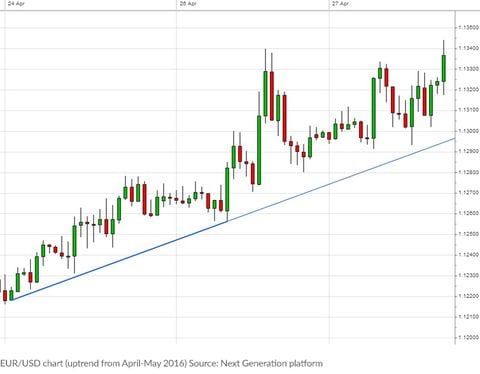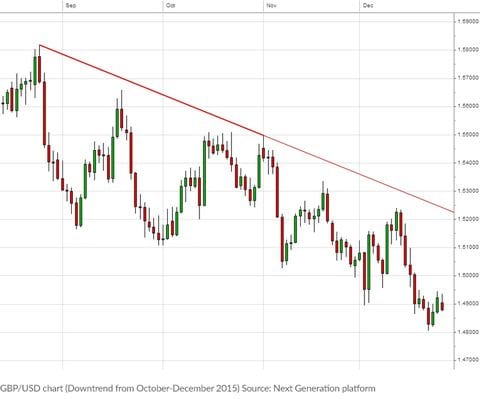How to build a simple trading strategy
When it comes to trading strategies, complicated does not necessarily mean better. Ultimately, the markets can only do one of three things: go up, down or sideways.
A simple trading strategy can still be an effective way of catching significant moves, meaning you can use it across a variety of different markets.
Technical analysis
At the core of many strategies is the idea of trading with the trend – the often referred to trend-following technique. Markets normally take a while to get to wherever they are going and trends can develop over hours, days, weeks or months.
The core to any trend-following approach is to first identify which way the trend is going, and use an opportunity of a slight change in this main trend to jump on board. For instance, if the market is in an uptrend then a trader would be looking to buy and if it’s in a downtrend then the trader would be looking to profit from a fall by selling short.
Trendline analysis
Trend lines are a simple but effective way of identifying trends to build a trading strategy. These sit below the lows in an uptrend, and above the highs in a downtrend. The below examples will illustrate the textbook approach of drawing these on a chart.


If we think that success in trading is down to playing the probabilities, then trading with the trend as part of a simple strategy would put us on the right side of market sentiment – momentum should be in our favour. Trends of course do not last forever and the trader needs to be ready to change opinion when the market does – but trend-following for most people can be a more effective strategy than trying to blindly pick tops and bottoms.
Support and resistance
As can be seen from the trend lines drawn on the two charts above, they act almost as a barrier to the price. A market which is trending upwards will have the occasional sell-off – markets do not move in straight lines, and this ebb and flow is all part of the trend. The trend-following trader will use weakness in an uptrend as an opportunity to buy in, using that trend line as a reference point. In an uptrend, while the market is above the trend line the trend is thought to still be intact and this can be a core component of an effective but simple trading strategy.
The opposite applies in a downtrend. In the GBP/USD chart above, the market does have the occasional strong rally but it fails to break through that falling trend line. These short bursts of strength would be used by trend-following traders to short sell and potentially profit from the next move lower. Only if the trend line gets broken by the price does it start to suggest that the trend you are following is running out of steam.
Trading market rises and falls
Spotting trends is easy on hindsight, but unless we have a time machine, we all have to trade in the present. There is a very good saying from a veteran trader that the trend really should jump out at you if it is there – you shouldn’t have to squint at the chart to try and spot it.
The classic definition of an uptrend is higher highs and higher lows, while a downtrend is a steady procession of lower lows and lower highs. These should be easy to spot in your chosen timeframe. Adding the trend line will give you a reference point for where to enter a trade and, just as importantly, where to come out if the trend ends.
Disclaimer
CMC Markets is an execution only service provider. The material (whether or not it states any opinions) is for general information purposes only, and does not take into account your personal circumstances or objectives. Nothing in this material is (or should be considered to be) financial, investment or other advice on which reliance should be placed. No opinion given in the material constitutes a recommendation by CMC Markets or the author that any particular investment, security, transaction or investment strategy is suitable for any specific person.
CMC Markets does not endorse or offer opinion on the trading strategies used by the author. Their trading strategies do not guarantee any return and CMC Markets shall not be held responsible for any loss that you may incur, either directly or indirectly, arising from any investment based on any information contained herein.